12 Best Vulnerability Management Tools of 2025
Discover the 12 best vulnerability management tools for 2025. Our in-depth review covers features, pros, cons, and use cases to secure your assets.
- Home
- Compliance HubHub
- 12 Best Vulnerability Management Tools of 2025
In today's complex digital landscape, simply finding vulnerabilities isn't enough. An effective vulnerability management program requires a tool that not only identifies weaknesses but also prioritizes them based on real-world risk, integrates with your existing workflows, and provides actionable remediation guidance. Choosing the right platform is a critical security decision that impacts everything from developer productivity to audit readiness. However, the market is crowded with options, from traditional network scanners to agentless cloud security platforms and developer-first tools. This guide cuts through the noise.
We'll provide a detailed analysis of the 12 best vulnerability management tools, examining their unique strengths, ideal use cases, and practical limitations. This will help you make an informed choice that aligns with your specific technical and business needs, whether you're a startup targeting fast SOC 2 certification or a mid-market team needing automated compliance.
This list is designed to be a practical resource. Each entry includes:
- A concise breakdown of key features and strengths.
- Honest pros, cons, and pricing considerations.
- Specific use cases for different organizational needs.
- Screenshots and direct links to help your evaluation.
Evaluating these platforms is a crucial step, but some organizations may also need external expertise. Understanding the process for selecting a managed IT security service can provide a valuable framework for a more comprehensive security strategy. Our goal is to equip you with the detailed information needed to confidently select a vulnerability management partner, whether that's a new software platform, a service provider, or a combination of both. Let’s dive into the top solutions available today.
1. Tenable (Tenable Vulnerability Management, Nessus)
Tenable is a cornerstone in the cybersecurity landscape, widely recognized for its powerful Nessus scanner and its comprehensive cloud platform, Tenable Vulnerability Management. This platform excels at traditional network scanning and extends its capabilities to modern environments, including cloud infrastructure and web applications. It stands out as one of the best vulnerability management tools for organizations that need a proven, reliable solution that can scale from a single scanner to a full-enterprise deployment.
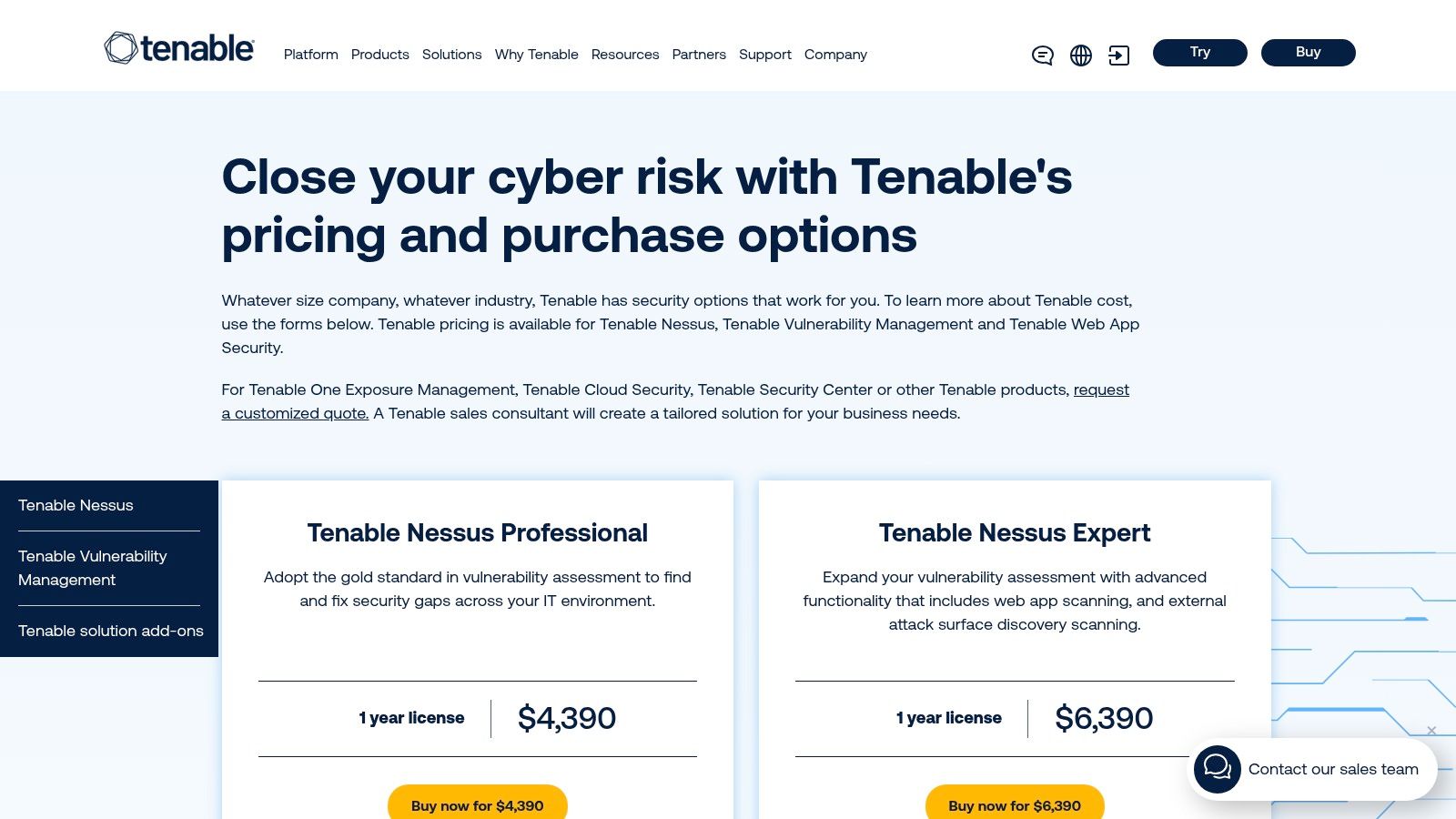
Tenable's strength lies in its extensive plugin library and pre-built compliance profiles, which provide immediate value for teams pursuing certifications like SOC 2 or ISO 27001. The risk-based prioritization helps security teams focus on the most critical threats first, cutting through the noise of low-impact vulnerabilities. Getting started is straightforward, with clear online pricing for common bundles and a fast trial process. A well-defined vulnerability management policy is crucial for maximizing the platform's effectiveness.
Key Features & Considerations
Tenable's platform is built to deliver clarity and actionable insights, but its licensing model requires careful management.
| Feature | Description |
|---|---|
| Asset-Based Licensing | Licensing is based on the number of assets, but its elastic counting can be complex to manage in dynamic hybrid or cloud environments. |
| Extensive Plugin Coverage | Boasts one of the industry's largest libraries of vulnerability checks (plugins) and compliance templates, ensuring broad coverage. |
| Risk-Based Prioritization | Uses a Vulnerability Priority Rating (VPR) to score vulnerabilities based on threat intelligence, helping teams prioritize remediation efforts. |
| Deployment & Pricing | Easy to deploy with clear online pricing for standard packages. However, advanced solutions require a custom quote through a sales team. |
Website: https://www.tenable.com/buy
2. Rapid7 InsightVM
Rapid7 InsightVM is a powerful contender in the vulnerability management space, recognized for its comprehensive risk-based approach and strong focus on remediation workflows. The platform combines agent-based and agentless scanning to provide a unified view of risk across cloud, virtual, remote, and physical infrastructure. It stands out as one of the best vulnerability management tools for organizations that need to not only identify vulnerabilities but also effectively manage and track the entire remediation lifecycle from discovery to closure.
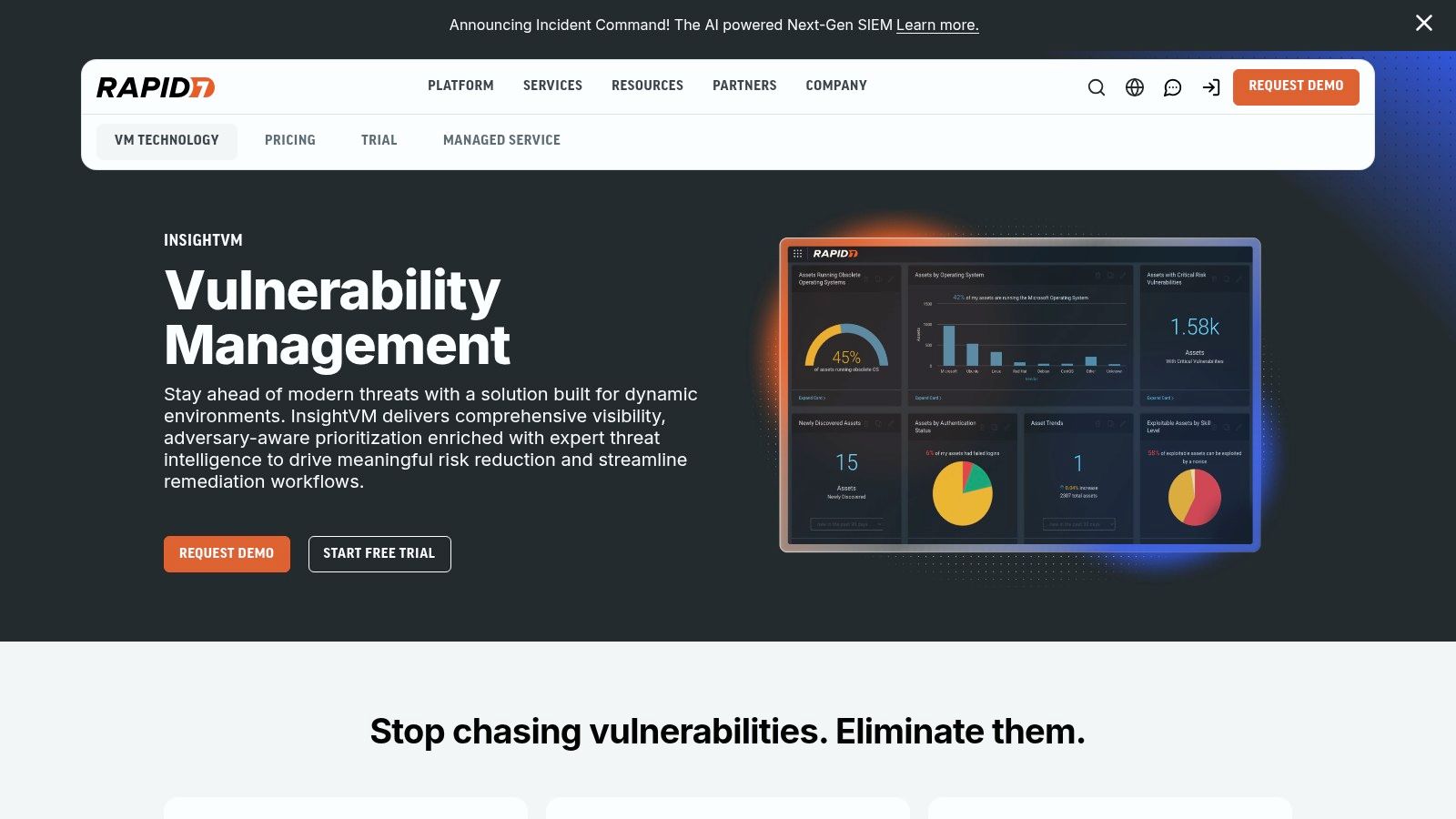
InsightVM's strength is its ability to translate scan data into actionable remediation projects. The platform’s live dashboards and goal-tracking features allow security teams to set and monitor service-level agreements (SLAs) for patching, providing clear metrics for stakeholders. Integrations with ITSM tools like Jira streamline ticket creation, while its Active Risk scoring prioritizes threats based on real-world exploitability. The platform's capabilities also make it a valuable asset alongside other security solutions, such as some of the best penetration testing tools available.
Key Features & Considerations
Rapid7 InsightVM focuses heavily on operationalizing vulnerability data, but its full potential is often realized within the broader Rapid7 ecosystem.
| Feature | Description |
|---|---|
| Unified Agent & Discovery | A single lightweight agent provides continuous visibility and collects data from assets, complemented by dynamic discovery of new devices. |
| Active Risk Scoring | Moves beyond standard CVSS by incorporating threat intelligence and exploit data to provide a more accurate 1-1000 risk score for prioritization. |
| Remediation & SLA Tracking | Offers built-in project management, goals, and SLA tracking to drive remediation efforts and measure program effectiveness over time. |
| Deployment & Pricing | Provides transparent, tiered per-asset pricing guidance online but requires annual billing and a minimum asset count for contracts. |
Website: https://www.rapid7.com/products/insightvm/
3. Qualys VMDR (Vulnerability Management, Detection & Response)
Qualys VMDR offers a comprehensive, all-in-one cloud platform that consolidates asset discovery, vulnerability assessment, threat prioritization, and patch management. It is designed for hybrid IT environments, seamlessly integrating cloud agents and virtual scanners to provide continuous visibility. Qualys stands out as one of the best vulnerability management tools for organizations that prioritize a unified approach, seeking to reduce their tech stack and streamline workflows from detection to remediation.
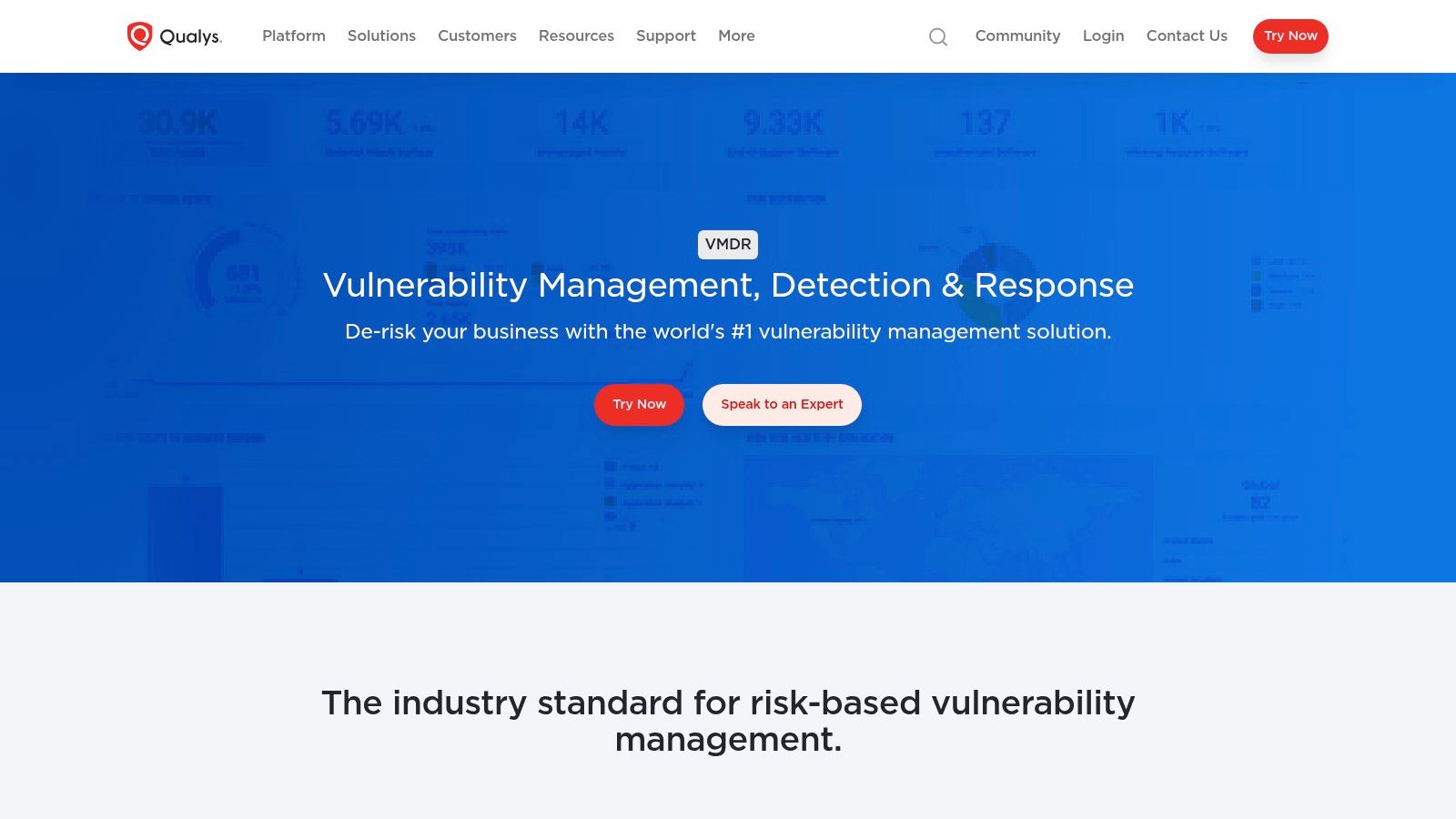
The platform's strength is its end-to-end lifecycle management, which allows teams to not only identify and prioritize vulnerabilities but also deploy patches directly from the same console. Its TruRisk scoring system leverages real-time threat intelligence to help focus remediation on the most significant threats. This integrated system aligns well with broader compliance needs, making it a valuable part of a larger strategy that includes a variety of top risk management software . However, the platform's power can feel complex, and pricing is not transparent, requiring direct engagement with sales.
Key Features & Considerations
Qualys VMDR is built for unified visibility and action, but its powerful feature set requires careful implementation to maximize value.
| Feature | Description |
|---|---|
| Unified Cloud Platform | Combines asset management, vulnerability scanning, prioritization, and patch management into a single solution, reducing tool sprawl. |
| Cloud Agents & Virtual Scanners | Offers flexible deployment with lightweight agents for real-time data on endpoints and scanners for network-wide discovery in hybrid environments. |
| TruRisk Prioritization | Uses real-time threat intelligence and asset context to generate a risk score, helping teams focus on vulnerabilities actively being exploited. |
| Integrated Patch Management | Allows for direct deployment of patches for Windows, macOS, and various third-party applications from within the Qualys platform. |
Website: https://www.qualys.com/apps/vulnerability-management-detection-response/
4. Microsoft Defender Vulnerability Management (MDVM)
Microsoft Defender Vulnerability Management (MDVM) is an endpoint-centric solution deeply integrated into the wider Microsoft 365 security ecosystem. It provides continuous asset discovery, vulnerability assessment, and risk-based prioritization directly within the familiar Defender portal. This makes it one of the best vulnerability management tools for organizations already invested in Microsoft's security stack, particularly those with M365 E5 licenses, offering a seamless and unified approach to securing endpoints.
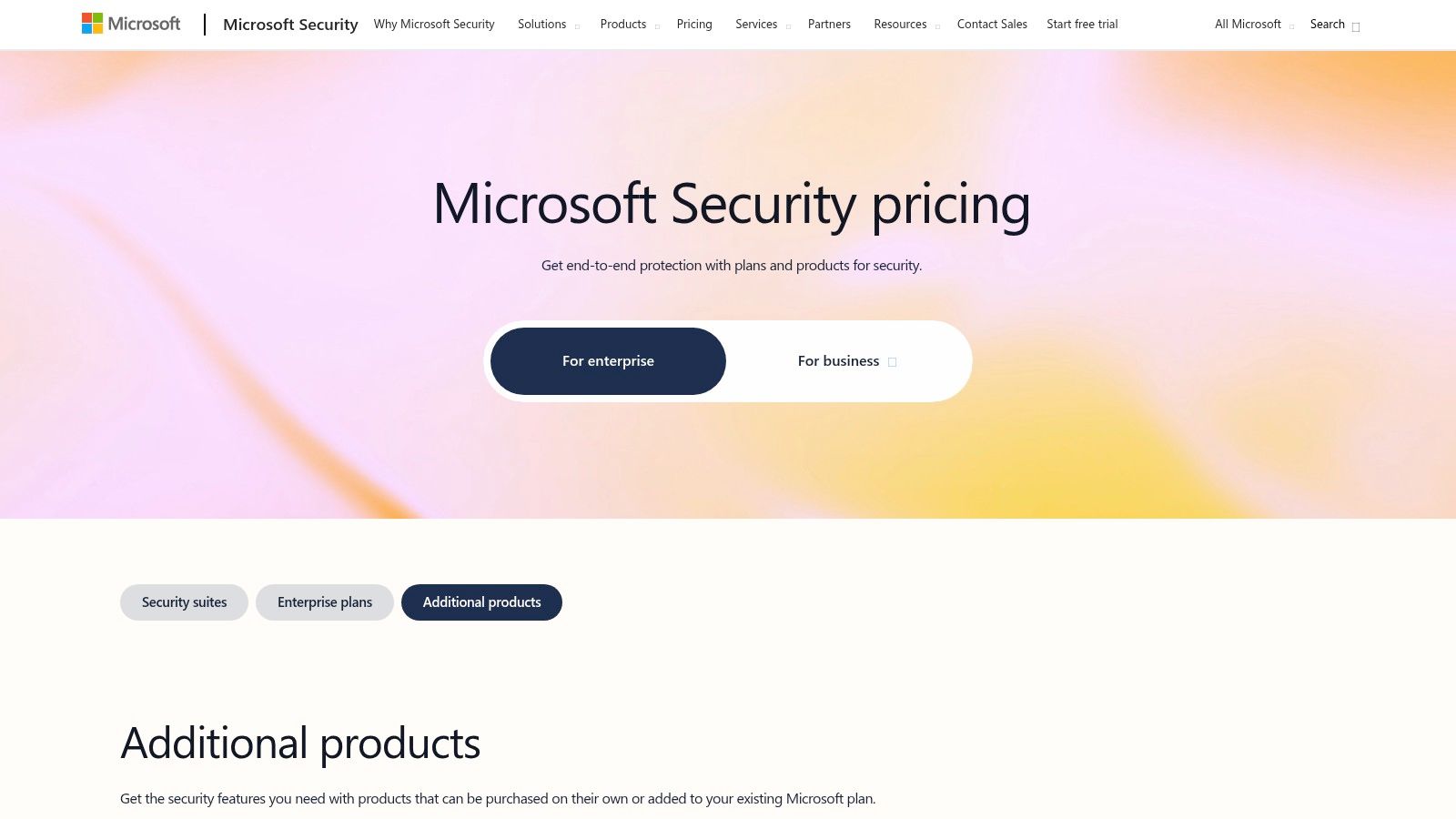
MDVM's key advantage is its native integration, eliminating the need for a separate agent on devices already running Defender for Endpoint. This simplifies deployment and management significantly. For organizations leveraging Microsoft's ecosystem, understanding methods like automating agent deployment with Microsoft Intune can further streamline the rollout of security solutions across the enterprise. The platform centralizes security recommendations and remediation tracking, linking vulnerabilities directly to endpoint detection and response (EDR) alerts for better context.
Key Features & Considerations
MDVM excels at providing a unified security posture but requires navigating Microsoft's complex licensing SKUs.
| Feature | Description |
|---|---|
| Unified Agent & Console | Leverages the existing Defender for Endpoint agent, providing vulnerability data within the same Microsoft 365 Defender portal. |
| Risk-Based Prioritization | Correlates vulnerability data with threat intelligence and asset value to generate prioritized remediation recommendations. |
| Broad Device Coverage | Supports a wide range of operating systems, including Windows, macOS, Linux, Android, and iOS, providing comprehensive endpoint visibility. |
| Licensing & Deployment | Offered as a standalone add-on or included in higher-tier plans like Defender for Endpoint Plan 2 and M365 E5. Pricing is per-user. |
Website: https://www.microsoft.com/en-us/security/pricing/enterprise/featured-security-products
5. CrowdStrike Falcon Spotlight / Falcon Exposure Management
CrowdStrike Falcon Spotlight shifts vulnerability management from periodic network scans to continuous, real-time endpoint assessment. As part of the broader Falcon platform, it leverages the same lightweight agent used for EDR/XDR, eliminating the need for separate scanners and infrastructure. This agent-based approach provides immediate visibility into vulnerabilities on endpoints the moment they connect, making it one of the best vulnerability management tools for organizations heavily invested in the CrowdStrike ecosystem.
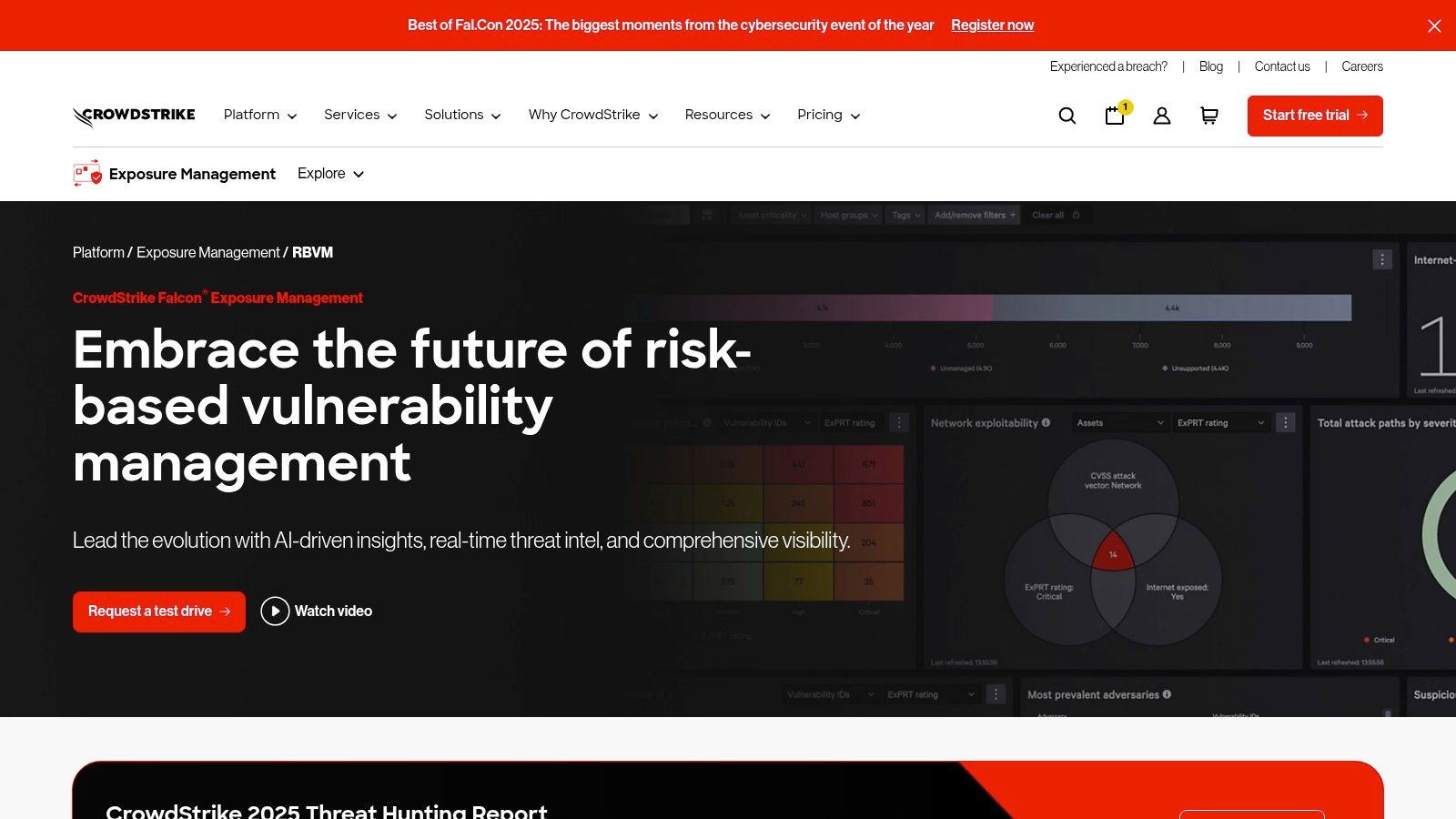
Falcon Spotlight's key differentiator is its seamless integration with threat detection and response. It moves beyond just listing CVEs by using threat intelligence to prioritize vulnerabilities actively being exploited in the wild and mapping potential attack paths. This synergy allows security teams to instantly pivot from a vulnerability detection to seeing which endpoints are affected and whether an active threat is present. The focus is on speed and operational efficiency, especially for security operations centers (SOCs) already using Falcon.
Key Features & Considerations
CrowdStrike's approach provides unparalleled speed for endpoint vulnerability data but is inherently tied to its agent deployment and licensing.
| Feature | Description |
|---|---|
| Scanless, Agent-Based Model | Collects vulnerability data in real-time via the existing Falcon agent, providing always-on visibility without scheduled scans or network traffic. |
| Exploit & Threat Prioritization | Prioritizes vulnerabilities based on real-world threat intelligence and active exploitation, helping teams focus on the most immediate risks. |
| Integrated Platform Synergy | Tightly integrated with CrowdStrike's EDR/XDR capabilities, allowing for unified response actions directly from vulnerability findings. |
| Deployment & Pricing | Deployed as a module within the Falcon platform. Pricing is quote-based and typically bundled with other Falcon products, reflecting a premium offering. |
Website: https://www.crowdstrike.com/products/exposure-management/falcon-spotlight-vulnerability-management/
6. Wiz (Cloud Vulnerability & Exposure Management)
Wiz has rapidly emerged as a leader in cloud security, offering a powerful, agentless platform that specializes in vulnerability and exposure management for cloud-native environments. It provides a unified view of risks across multi-cloud infrastructures like AWS, Azure, and GCP by correlating vulnerabilities with misconfigurations, exposed secrets, and network exposure. This contextual approach makes Wiz one of the best vulnerability management tools for organizations looking to secure their cloud footprint without the overhead of deploying traditional agents.
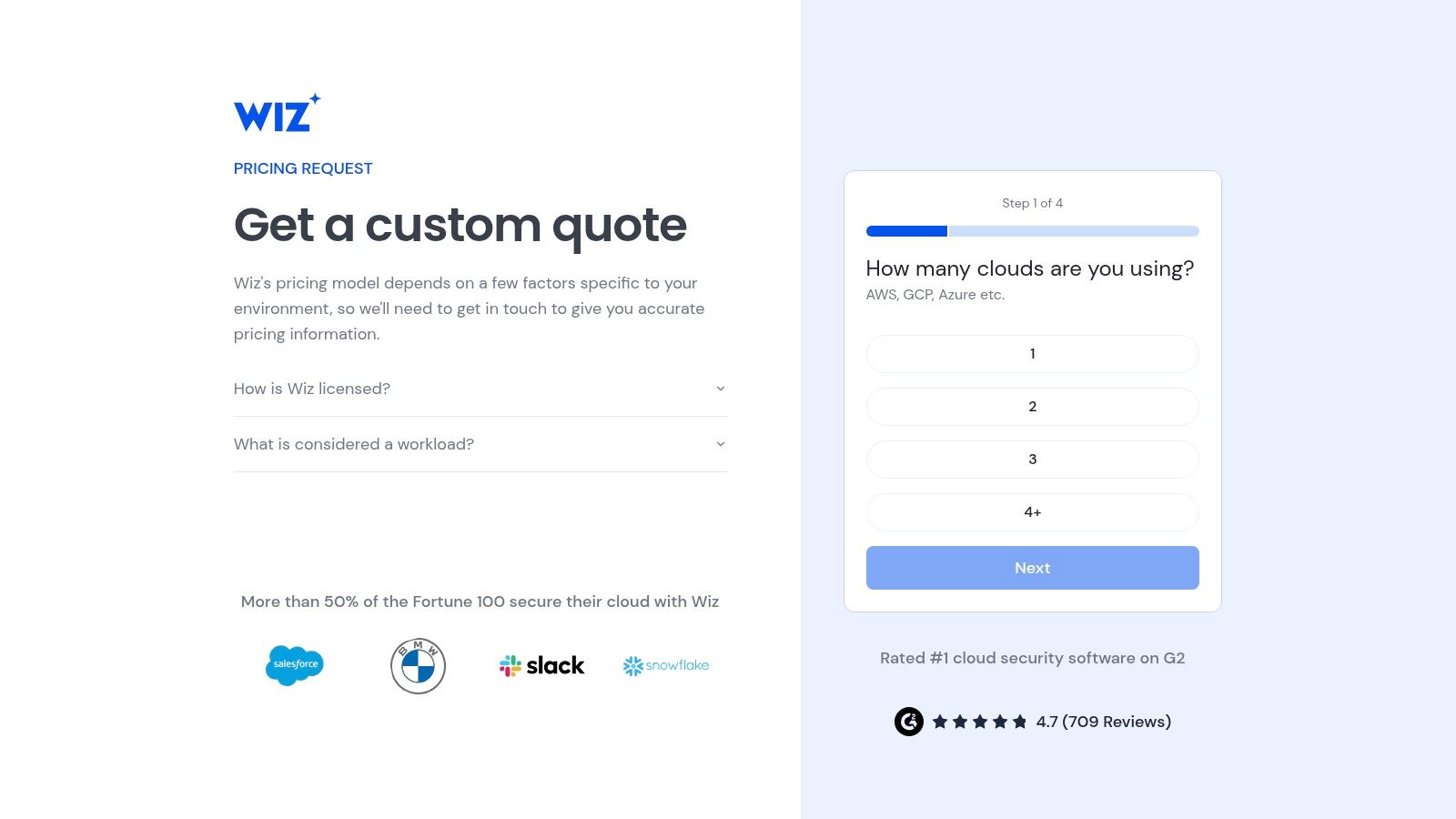
The platform's key differentiator is its ability to build a comprehensive graph of cloud assets and their relationships, allowing security teams to quickly identify and prioritize the most critical attack paths. Deployment is remarkably fast, connecting via APIs to provide visibility in minutes. Wiz's workload-based pricing model, while geared towards enterprise customers, offers clarity for budget planning, and its availability on cloud marketplaces simplifies procurement for US-based companies.
Key Features & Considerations
Wiz delivers deep cloud visibility and prioritizes real-world risk, but its enterprise focus means pricing can be a significant investment.
| Feature | Description |
|---|---|
| Agentless Cloud Scanning | Scans cloud workloads and configurations via API integrations without requiring agents, enabling rapid deployment and broad visibility. |
| Attack Path Analysis | Identifies and prioritizes toxic combinations of risks, such as a public-facing container with a critical vulnerability and high privileges. |
| Workload-Based Pricing | Pricing is based on the number of cloud workloads (VMs, containers, etc.), with optional modules for code scanning and other capabilities. |
| Marketplace Availability | Available through AWS, Azure, and GCP marketplaces, which can streamline procurement and budget allocation for US-based organizations. |
Website: https://www.wiz.io/pricing
7. Orca Security (Agentless CNAPP with Vulnerability Management)
Orca Security has carved out a distinct space in the market with its agentless-first Cloud-Native Application Protection Platform (CNAPP). Instead of deploying agents on every asset, Orca uses a patented SideScanning technology to read the cloud provider's runtime block storage and metadata, providing 100% coverage almost instantly. This approach makes it one of the best vulnerability management tools for organizations that prioritize speed, ease of deployment, and complete visibility across complex multi-cloud environments like AWS, Azure, and GCP.
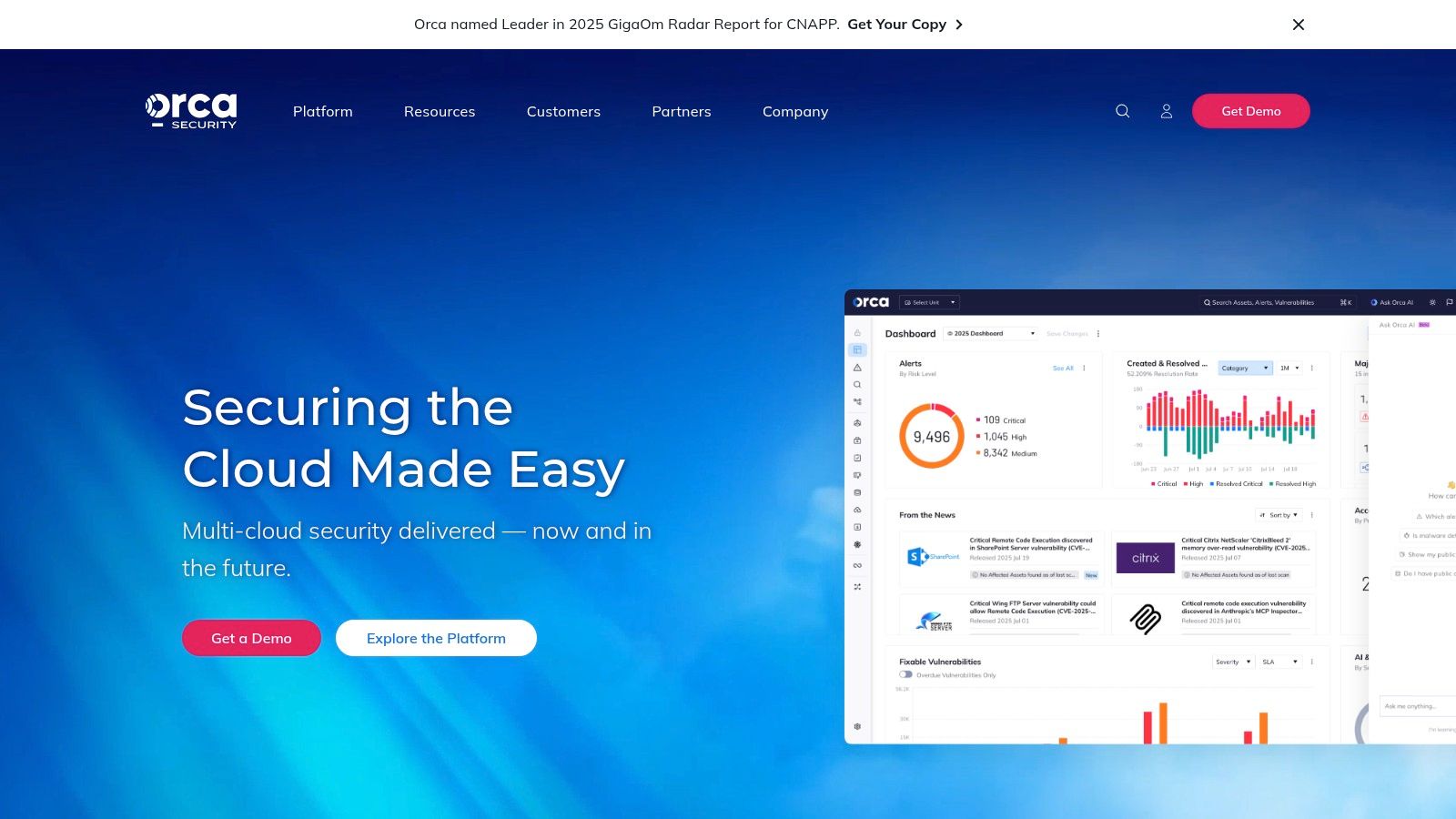
The platform's strength is its ability to contextualize risk. Orca doesn't just list vulnerabilities; it maps out attack paths, showing how a combination of misconfigurations, vulnerabilities, and exposed secrets could lead to a breach. This focus on contextual risk is invaluable for prioritizing remediation. Getting started is remarkably fast, with a free trial available directly through the AWS Marketplace, allowing teams to see value in hours. This capability also extends to identifying risks from external services, a key component of a robust third-party risk management strategy.
Key Features & Considerations
Orca’s agentless model is a significant advantage for cloud-native teams, but its comprehensive scope may be more than some smaller organizations require.
| Feature | Description |
|---|---|
| Agentless SideScanning | Provides deep, workload-level visibility across 100% of cloud assets without the performance overhead or deployment friction of traditional agents. |
| Unified Risk Context | Combines vulnerabilities, misconfigurations, malware, and identity risks into a single contextual graph to prioritize the most critical attack paths. |
| Broad Cloud Coverage | Scans everything from VMs and containers to serverless functions and Infrastructure as Code (IaC) templates, ensuring comprehensive cloud posture management. |
| Deployment & Pricing | A quick proof of concept is available via a marketplace free trial. Full platform pricing and tiers are quote-based and tailored to the environment. |
Website: https://orca.security/
8. Greenbone (OpenVAS / Greenbone Enterprise and Cloud)
Greenbone leverages its open-source roots with OpenVAS to offer a flexible and accessible vulnerability management solution. It caters to a wide spectrum of users, from hobbyists and small businesses using the free Greenbone Community Edition to large enterprises requiring the robust support and advanced features of its Enterprise Appliances and Cloud services. This unique positioning makes it one of the best vulnerability management tools for organizations that value an open-source foundation but need a clear upgrade path to a commercially supported product.
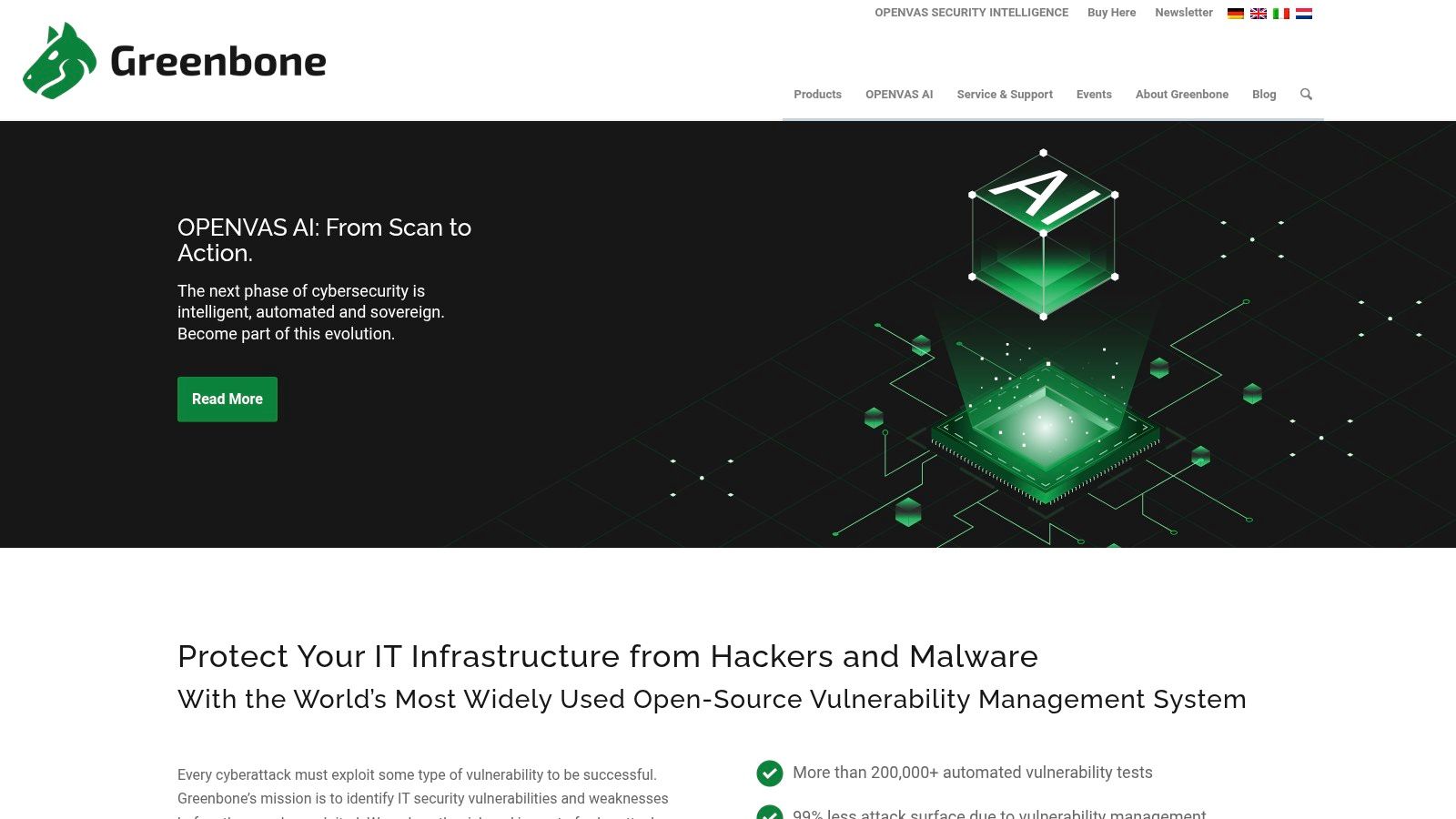
The platform's strength lies in its adaptable deployment models and the extensive Greenbone Security Feed, which receives daily updates of Network Vulnerability Tests (NVTs). The free community edition provides a powerful entry point for teams to build their vulnerability management program without initial financial commitment. However, moving to the enterprise versions is necessary for dedicated support, comprehensive reporting, and service-level agreements, which are critical for business operations and compliance mandates.
Key Features & Considerations
Greenbone's ecosystem offers a path from free, community-driven scanning to a fully supported enterprise-grade platform.
| Feature | Description |
|---|---|
| Open-Source Foundation | The free Greenbone Community Edition (formerly OpenVAS) offers a powerful, no-cost entry point for vulnerability scanning and assessment. |
| Flexible Deployment | Available as on-premises physical or virtual appliances (Greenbone Enterprise) and as a fully managed cloud service for maximum flexibility. |
| Comprehensive Feeds | Provides daily-updated vulnerability tests through both a community feed and a more extensive, professionally curated enterprise feed. |
| Pricing & Support | While the community edition is free, commercial pricing lacks transparency and requires direct engagement. Enterprise tiers are essential for support. |
Website: https://www.greenbone.net/en/
9. Snyk (Developer-first vulnerability management for code, open source, containers)
Snyk shifts vulnerability management left, embedding security directly into the software development lifecycle. It is a developer-centric platform that focuses on securing code, open-source dependencies, containers, and Infrastructure as Code (IaC). Snyk stands out as one of the best vulnerability management tools for organizations aiming to empower developers to find and fix vulnerabilities early in their workflow, rather than relying solely on post-deployment security scans.
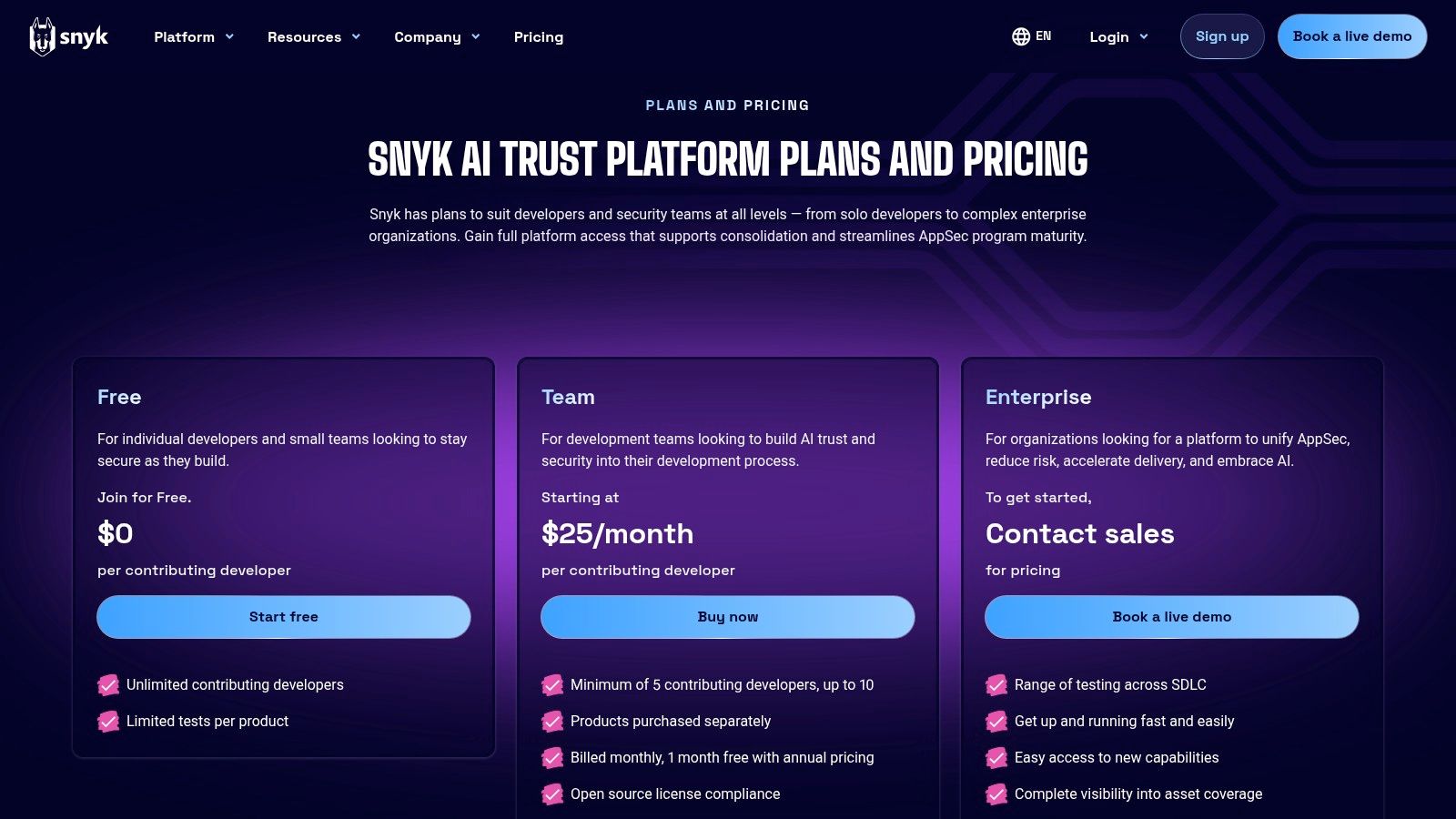
The platform's strength lies in its seamless integration with developer tools like Git, CI/CD pipelines, and IDEs, providing actionable context and automated fix suggestions. This developer-first approach reduces friction between security and development teams and accelerates remediation. Snyk's generous free tier makes it highly accessible for individual developers, open-source projects, and small teams to get started, while its enterprise plans provide the governance and scale needed for larger organizations.
Key Features & Considerations
Snyk is built to make application security a natural part of the development process, but scaling requires moving to enterprise plans.
| Feature | Description |
|---|---|
| Developer-First Integrations | Integrates directly into source code management systems (like GitHub, GitLab) and CI/CD pipelines to scan code and dependencies automatically. |
| Comprehensive AppSec Scope | Provides a single platform to scan proprietary code (SAST), open-source dependencies (SCA), container images, and IaC configurations. |
| Actionable Remediation Advice | Offers clear, context-aware fix recommendations, often including one-click pull requests to upgrade vulnerable packages. |
| Pricing & Accessibility | A robust free tier allows for easy adoption and testing. Paid plans are available for larger teams, with enterprise features offered via a custom quote. |
Website: https://snyk.io/plans/
10. AWS Marketplace (Security/Vulnerability Management listings)
While not a tool itself, the AWS Marketplace is a critical procurement channel for organizations deeply integrated with the AWS ecosystem. It serves as a centralized hub to discover, purchase, and deploy a wide array of the best vulnerability management tools, including major players like Tenable, Wiz, and Orca Security. This approach is ideal for teams looking to simplify vendor management and consolidate billing directly through their existing AWS account.
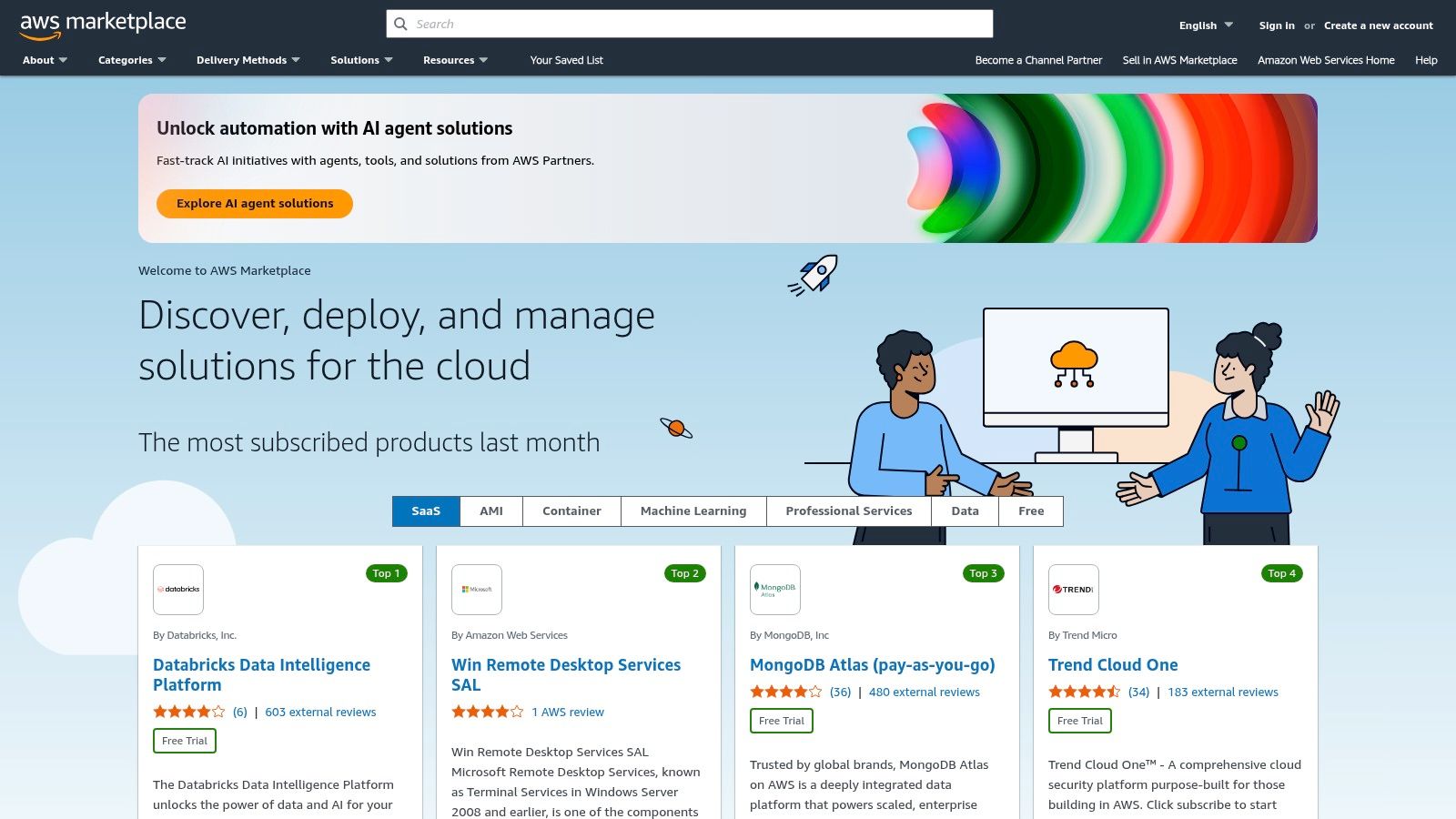
The primary advantage of using the AWS Marketplace is the streamlined procurement process. It allows for one-click trials and flexible contract terms, often with private offers that enable negotiated pricing directly with vendors. For many solutions, transparent SKUs and example pricing are available, removing some of the friction associated with traditional sales cycles. This makes it an efficient pathway for AWS customers to acquire and manage their security software stack.
Key Features & Considerations
The Marketplace simplifies buying but requires diligence, as license models and support levels vary significantly between vendors.
| Feature | Description |
|---|---|
| Streamlined Procurement | Consolidates purchasing and billing through a single AWS account, simplifying vendor management and often counting toward AWS spend commits. |
| Private Offers | Enables custom pricing, terms, and conditions to be negotiated directly with software vendors, outside of standard public listings. |
| Flexible Contract Terms | Many tools offer contract options for 12, 24, or 36 months, providing flexibility to align with budget cycles and long-term planning. |
| Vendor & Product Variety | Offers a vast selection of tools, but licensing metrics (per asset, per user, etc.) and pricing transparency can differ greatly by vendor. |
Website: https://aws.amazon.com/marketplace/
11. Microsoft Azure Marketplace and Defender for Cloud ecosystem
For organizations deeply invested in the Microsoft Azure ecosystem, leveraging the native platform capabilities offers a highly integrated approach to vulnerability management. Microsoft Defender for Cloud acts as the central security posture management hub, integrating vulnerability assessment solutions for servers, containers, and databases. This makes it one of the best vulnerability management tools for teams seeking to unify security operations within their existing cloud environment, rather than adding a separate, standalone product.
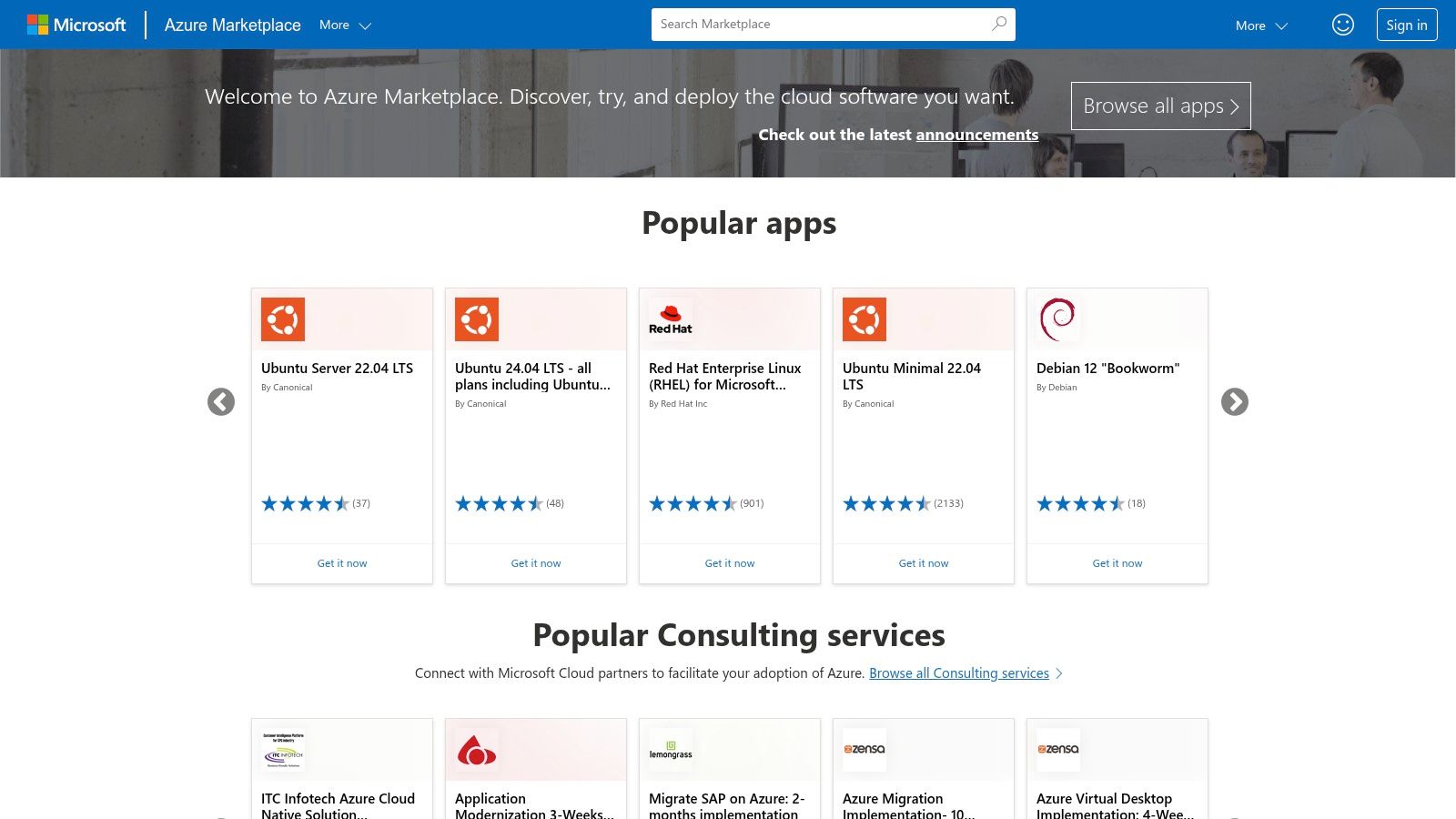
The primary strength of this approach is its seamless, policy-driven deployment. Vulnerability scanning can be enabled across subscriptions with a few clicks, and findings are funneled directly into Defender for Cloud's recommendations. This provides a single pane of glass for identifying, prioritizing, and tracking remediation. While Microsoft provides its own scanner (Microsoft Defender Vulnerability Management), the Azure Marketplace also allows for the integration of third-party solutions, offering flexibility while maintaining centralized oversight and billing.
Key Features & Considerations
The Azure-native approach prioritizes streamlined operations and integration over a vast, independent feature set.
| Feature | Description |
|---|---|
| Integrated Azure Billing | All costs, whether for native scanners or marketplace partner tools, are consolidated into the monthly Azure bill, simplifying procurement and budget management. |
| Policy-Driven Enablement | Use Azure Policy to automatically deploy and configure vulnerability scanners across new and existing resources, ensuring consistent coverage without manual intervention. |
| Centralized Remediation Workflows | Findings from all integrated scanners are centralized in Defender for Cloud, providing a unified list of security recommendations with built-in prioritization. |
| Scanner Deprecation & Discovery | Microsoft is consolidating its offerings around Microsoft Defender Vulnerability Management, deprecating some older integrations. Finding the right solution can be complex. |
Website: https://azuremarketplace.microsoft.com/
12. G2 Vulnerability Management Category
G2 serves as an essential peer-review platform rather than a direct vulnerability management tool. It provides a comprehensive, crowd-sourced perspective on the market, featuring verified user reviews, ratings, and detailed comparisons. For teams in the evaluation phase, G2 is an invaluable resource for shortlisting vendors and understanding real-world user satisfaction, making it a critical first stop when searching for the best vulnerability management tools.
The platform's strength is its Grid Report, which visually plots solutions based on user satisfaction and market presence, offering a quick way to identify leaders and niche players. Users can filter by company size, industry, and required features to find solutions that match their specific needs. While it's not a tool you purchase, G2 provides the social proof and peer validation necessary to make an informed buying decision, helping you compare marketing claims against actual user experiences before committing to a demo or trial.
Key Features & Considerations
G2 helps validate vendor claims with real user feedback, but it's important to analyze reviews critically and consider potential biases.
| Feature | Description |
|---|---|
| Verified User Reviews | Aggregates detailed reviews from authenticated users, providing insights into ease of use, quality of support, and implementation challenges. |
| Grid Reports & Rankings | Visually ranks vendors in a quadrant format based on user satisfaction and market presence, helping to quickly identify market leaders. |
| Feature & Segment Filtering | Allows buyers to filter and compare tools based on specific criteria like deployment type (cloud, on-premise) and business segment. |
| Vendor Shortlisting | Acts as a research and validation platform to build and confirm a vendor shortlist before engaging with sales teams. It is not a marketplace. |
Website: https://www.g2.com/categories/vulnerability-management
Top 12 Vulnerability Management Tools Comparison
| Solution | Core Features / Capabilities | User Experience / Quality Metrics | Value Proposition | Target Audience | Price & Licensing |
|---|---|---|---|---|---|
| Tenable (Nessus) | Asset-based licensing; large plugin coverage; risk prioritization dashboards | Fast trial & deploy; strong brand presence | Clear online pricing; comprehensive scanning | Org. needing traditional + cloud scanning | Elastic asset licensing; some packages sales-assisted |
| Rapid7 InsightVM | Agent-based & agentless scanning; active risk scoring; ITSM integrations | Strong remediation workflows; transparent tiered pricing | Unified platform; remediation focus | Teams needing integrated workflows | Annual billing; min asset counts |
| Qualys VMDR | Asset discovery; TruRisk scoring; patch management; hybrid environment support | Established compliance; broad coverage | Unified cloud platform; strong reporting | Hybrid cloud & compliance teams | Pricing varies; often quote-based |
| Microsoft Defender VM (MDVM) | Continuous assessment; multi-OS device coverage; MS 365 integration | Simple MS add-on experience; competitive pricing | Endpoint-centric; seamless MS stack fit | MS 365 & Defender users | Per-user pricing; SKU nuances |
| CrowdStrike Falcon Spotlight | Always-on Falcon agent; AI prioritization; deep threat intel integration | Minimal infra overhead; fast time to value | Tight Falcon platform synergy | Falcon platform customers | Quote-based; can be premium |
| Wiz | Agentless cloud inventory; exposure risk prioritization; multi-cloud support | Rapid multi-cloud deployment; streamlined procurement | Cloud-first vulnerability & misconfiguration | Multi-cloud enterprises | Workload & module based pricing |
| Orca Security | Agentless multi-cloud discovery; risk graphs; compliance & container coverage | Quick PoC via AWS Marketplace | Agentless, fast coverage | Teams avoiding agent deployment | Quote-based pricing |
| Greenbone (OpenVAS) | Daily updated vulnerability tests; flexible deployment; free community edition | Lowest entry cost; flexible deployment | Open-source roots with paid support | Budget-conscious teams | Community free; commercial varies |
| Snyk | Developer-focused; scans code, containers, IaC; CI/CD integration | Easy developer adoption; free tier available | Dev-centric vulnerability management | Development teams | Free & quote-based enterprise pricing |
| AWS Marketplace | One-click trials/contracts; vendor insights; private offers | Streamlined procurement & billing | Central AWS channel for many tools | AWS customers & procurement teams | Varies per vendor & offer |
| Azure Marketplace & Defender | Azure billing; Defender integration; built-in scanning | Smooth Azure integration | Native deployment & remediation workflows | Azure users | Service-specific offers; integration focused |
| G2 Vulnerability Management | Curated vendor lists; verified reviews; filters | Peer insights; buyer validation | Trusted review & comparison site | Buyers researching VM tools | Free; links to vendors |
Integrating Vulnerability Data into Your Broader Compliance Strategy
Navigating the landscape of vulnerability management platforms reveals a diverse ecosystem of solutions, each with distinct strengths. We've explored everything from network-centric powerhouses like Tenable and Rapid7 to cloud-native innovators like Wiz and Orca, and developer-focused tools such as Snyk. Your journey to finding the right fit among the best vulnerability management tools is not just about picking the one with the most features; it's about aligning a platform's capabilities with your specific operational needs, technology stack, and compliance goals.
For many organizations, especially startups and mid-market SaaS companies, the end goal of vulnerability management extends beyond just patching security holes. It's about generating the evidence needed to achieve and maintain critical compliance certifications like SOC 2, ISO 27001, and HIPAA. A raw vulnerability scan report is just data; its true power is unlocked when it's translated into actionable compliance evidence. This is the critical final step where many manual processes fall short, creating a significant time and resource drain during audit cycles.
From Technical Scans to Auditable Evidence
The core challenge isn't finding vulnerabilities; modern scanners are incredibly effective at that. The real bottleneck is systematically collecting, documenting, and mapping the remediation of those vulnerabilities to specific compliance controls. An auditor doesn't just want to see that you run scans; they need proof that you have a repeatable, documented process for identifying, prioritizing, and fixing issues in a timely manner.
This is where the integration of your chosen vulnerability management tool with a broader compliance automation framework becomes a game-changer. Manually exporting scan results, creating tickets in a separate system, tracking their closure, and then gathering screenshots for an audit is an archaic and error-prone workflow. The most effective security programs close the loop between technical detection and business-level compliance reporting.
Actionable Steps for Selecting Your Tool
As you finalize your decision, move beyond the feature lists and consider these practical implementation factors:
- Integration is Non-Negotiable: Does the tool have robust APIs or pre-built connectors that can feed data into your existing systems (like Jira, Slack, or a compliance platform)? A tool that operates in a silo creates more manual work, not less.
- Prioritization That Makes Sense: Look for risk-based prioritization that considers more than just the CVSS score. Factors like asset criticality, exploitability, and business context are essential for focusing your team’s limited resources on the threats that truly matter.
- Define Your Scope: Are you primarily securing on-premise networks, a complex multi-cloud environment, or your application source code? Your primary use case will heavily influence your choice. A tool like Qualys VMDR excels at hybrid environments, while Wiz is built from the ground up for the cloud.
- Consider Your Team's Expertise: Some platforms, like Greenbone's open-source option, offer immense flexibility but require more hands-on expertise. Others, like Microsoft Defender Vulnerability Management, provide a more integrated, user-friendly experience for teams already invested in the Microsoft ecosystem.
Choosing from the best vulnerability management tools is a foundational pillar of a mature security posture. It’s the engine that powers your risk detection. However, to truly accelerate your journey to compliance and build a resilient, auditable security program, you need to connect that engine to a smart, automated chassis. By linking your technical vulnerability data directly to your compliance framework, you transform a periodic, reactive task into a continuous, proactive process that satisfies auditors and genuinely strengthens your defenses.
Ready to bridge the gap between vulnerability scanning and audit-readiness? Comp AI uses autonomous agents to connect directly to your chosen vulnerability management tool, automatically gathering evidence and mapping it to controls for SOC 2, ISO 27001, and more. Stop chasing screenshots and start building a continuously compliant security program by visiting Comp AI to see how you can automate your evidence collection.
Share this article
Help others discover this content
More from Compliance Hub
Explore more insights and stay ahead of regulatory requirements.
Your Essential Data Breach Response Plan Template
Build a robust data breach response plan template with our expert guide. Learn to manage incidents, protect your business, and maintain customer trust.
7 Data Retention Policy Examples to Implement in 2025
Explore 7 real-world data retention policy examples. Learn how to implement time-based, event-based, and value-based policies for optimal compliance.
12 Best Penetration Testing Tools for Security Pros in 2025
Discover the 12 best penetration testing tools of 2025. In-depth reviews of Burp Suite, Metasploit, Nessus, and more for ethical hacking.